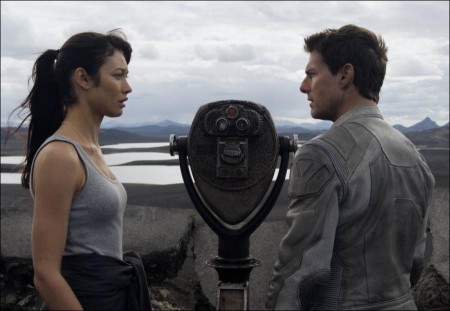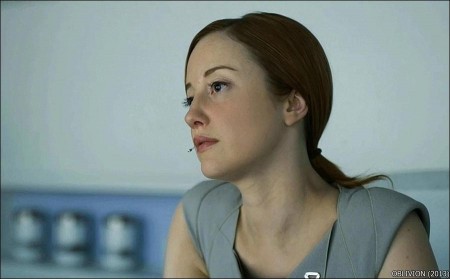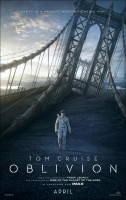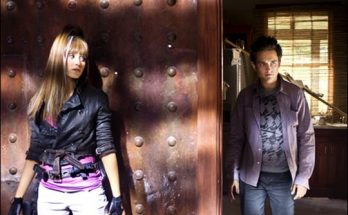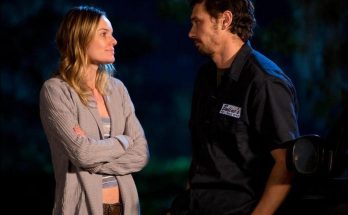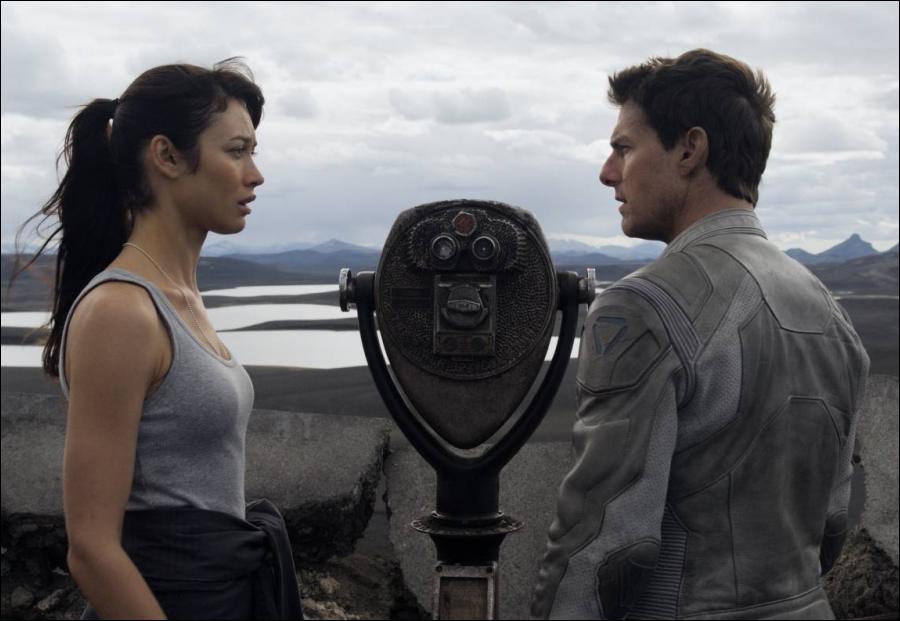Taglines: Earth is a memory worth fighting for.
Tom Cruise stars in Oblivion, an original and groundbreaking cinematic event from the director of TRON: Legacy. On a spectacular future Earth that has evolved beyond recognition, one man’s confrontation with the past will lead him on a journey of redemption and discovery as he battles to save mankind.
Jack Harper (Cruise) is one of the last few drone repairmen stationed on Earth. Part of a massive operation to extract vital resources after decades of war with a terrifying threat known as the Scavs, Jack’s mission is nearly complete.
Living in and patrolling the breathtaking skies from thousands of feet above, his soaring existence is brought crashing down when he rescues a beautiful stranger from a downed spacecraft. Her arrival triggers a chain of events that forces him to question everything he knows and puts the fate of humanity in his hands.
TOM CRUISE stars in Oblivion, an original and groundbreaking cinematic event from the visionary director of TRON: Legacy and producers of Rise of the Planet of the Apes. On a spectacular future Earth that has evolved beyond recognition, one man’s confrontation with the past will lead him on a journey of redemption and discovery as he battles to save mankind.
2077: Jack Harper (Cruise) serves as a security repairmen stationed on an evacuated Earth. Part of a massive operation to extract vital resources after decades of war with a terrifying alien threat who still scavenges what’s left of our planet, Jack’s mission is almost complete. In a matter of two weeks, he will join the remaining survivors on a lunar colony far from the war-torn world he has long called home.
Living in and patrolling the breathtaking skies from thousands of feet above, Jack’s soaring existence is brought crashing down after he rescues a beautiful stranger from a downed spacecraft. Drawn to Jack through a connection that transcends logic, her arrival triggers a chain of events that forces him to question everything he thought he knew. With a reality that is shattered as he discovers shocking truths that connect him to Earth of the past, Jack will be pushed to a heroism he didn’t know he contained within. The fate of humanity now rests solely in the hands of a man who believed our world was soon to be lost forever.
Oblivion Takes Flight: Production Begins (2013)
In 2005, five years before Joseph Kosinski directed his first feature, TRON: Legacy, the director wrote a 12-page story titled “Oblivion.” In his sci-fi adventure set in 2077—six decades after an alien invasion irradiates Earth—we follow the missions of Jack, a repairman on a nearly destroyed planet who is uncertain of his place in the universe.
Though the daredevil pilot serves as the last drone repairman stationed on our planet, Jack questions authority and is curiously drawn to preserving the world he once knew. When a gorgeous stranger crash-lands in front of him and upends everything that he believes, he awakes to a reality-shattering alternative truth that he must accept or reject. Ultimately, he becomes a leader for the remaining people of Earth, a man driven by purpose and a new destiny.
It was a dream of Kosinski’s to turn “Oblivion” into a screenplay, but the timing wasn’t quite right. The delay would prove fortuitous, however, when Kosinski met Barry Levine and Jesse Berger, co-founders of Radical Studios, several years later. Together, the men partnered to develop the story into an illustrated graphic novel known in the industry as an “ashcan,” written by ARVID NELSON, illustrated by ANDRÉE WALLIN and art directed by Kosinski, Levine and Radical Studios art director JEREMY BERGER. This would allow them to demonstrate to investors the direction in which they wanted to go with the property.
Kosinski reveals story elements of his graphic novel: “It’s an action-adventure set in the year 2077 after a massive war has left Earth uninhabited and in ruins. The story centers on Jack, a drone repairman who is an integral part of a larger mission. A wonderful mystery, unbeknownst to him, will be the key element to saving what is left of humanity.” What the director focused upon was the brutal honesty of the story. He adds: “There is a difference between those who ignore the truth and put their blinders on and the people who decide to take the truth head on—regardless of how hard it is to face what it means.”
Kosinski admits that this science-fiction saga was one he’d long been interested in telling. Growing up, he was enamored with such films as The Omega Man, Blade Runner and 2001: A Space Odyssey, books including “Hyperion” and TV shows like The Twilight Zone. The filmmaker admits that he loved the juxtaposition of a rugged backdrop against the stylish results of imagined future technology. He says: “I have always liked the ’70s sci-fi art by Chris Foss, Peter Elson and Chris Moore and knew that with VFX technology as advanced as it is today, I could combine CGI work and real landscapes seamlessly and create something unique.”
Levine and Berger were inspired by this young director’s vision, and Levine recalls his first reaction to the property: “When I read Joe’s story, I found it to be compelling, original and motivating of human nature and character. Oblivion is a great action-adventure, but at its core is that one character you are rooting for, and that is what makes for a great movie.”
Organically, this illustrated novel became a pitch for the film itself. There was overwhelming support from fans at 2010’s Comic-Con International in San Diego, at which Kosinski was also presenting footage for TRON: Legacy. Indeed, 30,000 copies of the graphic novel were distributed at the convention from the Radical Studio booth. Recalls Levine: “There was a line of 1,000 people at Comic-Con waiting for Joe to autograph a copy of the Oblivion ashcan. Along with the story, we created a memorable logo and illustrations that got a response from the get-go. It was a feat to take the leap and make this story into a screenplay. It’s an intellectual approach to a high-concept story with great set pieces. No one has seen anything like it before.”
Shortly after the team tested the waters with the property at Comic-Con, Universal Pictures came on board to develop the project with Kosinski, Radical Studios and Chernin Entertainment, and an Oblivion screenplay was in the works. Peter Chernin, the veteran producer who successfully rebooted a storied franchise with his 2011 blockbuster Rise of the Planet of the Apes, brought the lessons learned on that film—one that became the foremost contemporary model of combining heartfelt emotion with exciting, intelligent, speculative fiction. Chernin explains Oblivion’s draw: “Oblivion’s story connects with people because, though it is an action film, its essence is a movie about a guy trying to discover his humanity. That’s the core, and that is why it is ultimately so satisfying.”
For the feature, Kosinski and Levine were joined by fellow producers Dylan Clark, who had produced Rise of the Planet of the Apes alongside Chernin, and Duncan Henderson, known for maneuvering epic set pieces in films as varied as Master and Commander: The Far Side of the World and Harry Potter and the Sorcerer’s Stone.
With a shooting screenplay by Karl Gajdusek and Michael deBruyn, the filmmakers were finally equipped to begin the massive task that would become the Oblivion production. Clark reflects upon the design and undertaking: “Oblivion had this great visual world that Joe presented. It was something that happened to Earth, but it didn’t look dusty and dreary and dark. It looked vibrant, had a lot of colors and it felt unique. That’s what got us: the conceptual design of this was something we’ve never seen before.”
As his story takes place during the latter part of this century, Kosinski knew he needed a top design team to create a world that was most assuredly futuristic, but believable 60-plus years from current day. He brought on the key players he had worked with on TRON: Legacy to illustrate his version of this postapocalyptic world.
Henderson knew that his director would be up for the massive challenge, reflecting: “Joe’s a great storyteller. One of the things that intrigued me to want to do this picture was his original story. It lets an audience follow along in a way where you think you know something and then you discover it doesn’t quite make sense. The secrets just keep revealing themselves, like you’re peeling back an onion. You discover the story as you go; you get filled in with more facts and get a new picture. It’s one fantastic reveal after another.”
Beyond Practical: Visual Effects (2013)
VFX supervisor Barba previously teamed with Kosinski on TRON: Legacy. He viewed his goal on Oblivion to make Kosinski’s vision come to life in post so that the audience will believe the Bubbleship can fly, the Skytower rests 3,000 feet in the air on a platform, and that drones rocket by at warp speeds to chase down scavengers. Says Henderson: “There are huge VFX components that go into making a film of this scale. Nevertheless, Joe wanted to capture as much practically on set during filming as he could. We have a good balance of the two and they feed the story, so VFX are not just there to be a spectacle. Rather, they are plot-driven.”
The director reflects upon the world his VFX team helped to create: “From a visual effects standpoint, our biggest challenge was making sure that the digital elements in this movie integrate into the live-action photography seamlessly, because so much of this movie is in camera. We never wanted any of the digital elements to stick out. So when the drones are flying around, they had to feel like they were captured in camera on set.”
VFX producer and co-producer Steve Gaub came on board Oblivion early on to work on previsualization shots with Kosinski. Says Gaub: “We had a whole previsualization team doing early animations. The more we could lock into that, then the earlier on we could set the template of what we wanted to be practical photography versus what needed to be computer-generated, and what we wanted to be half and half.”
The VFX team chronicled everything that was happening on set so that they would have the necessary tools with which to work during postproduction (when they created the computer-generated imagery). Through the use of still references, they compiled as much data as possible to record what space and lighting—as well as intricate scene details—were used on each day of shooting.
Approximately 400 computer artists at VFX venues Digital Domain and Pixomondo relied upon the Oblivion on-set VFX team for incredibly specific texture and light data so that 3D models of everything from the set to the Bubbleship to the cast could be created for the VFX shots. Shadows proved to be a particular challenge on this film as most of the action takes place outdoors under bright sunlight…while computer creations need to match the real world flawlessly.
Oblivion (2013)
Directed by: Joseph Kosinski
Starring: Tom Cruise, Morgan Freeman, Olga Kurylenko, Zoe Bell, Nikolaj Coster-Waldau
Screenplay by: Joseph Kosinski, Karl Gajdusek
Production Design by: Darren Gilford
Cinematography by: Claudio Miranda
Film Editing by: Richard Francis-Bruce
Costume Design by: Marlene Stewart
Set Decoration by: Ronald R. Reiss, Gena Vazquez
Music by: Anthony Gonzalez, Joseph Trapanese
MPAA Rating: PG-13 for sci-fi action violence, brief strong language, and some sensuality / nudity.
Studio: Universal Pictures
Release Date: April 19, 2013
Visits: 87
